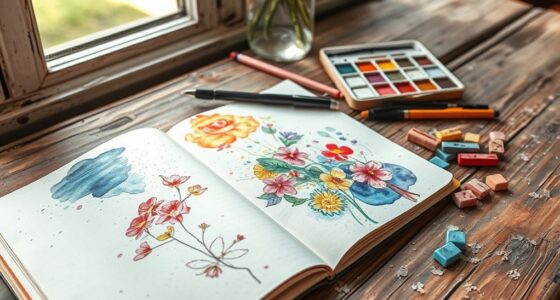Implementing corporate art therapy programs boosts employee well-being by offering creative outlets that reduce stress and enhance emotional intelligence. These activities foster self-expression, encourage teamwork through group projects, and create a safe space for emotional exploration. By aligning programs with organizational goals and securing qualified facilitators, you can improve morale and resilience. If you want to discover more about how to successfully integrate art therapy into your workplace, there’s plenty of practical guidance ahead.
Key Takeaways
- Art therapy fosters emotional expression and stress relief, improving overall employee well-being and mental health.
- Collaborative art activities strengthen team cohesion and enhance workplace trust and communication.
- Well-designed programs with qualified facilitators and safe spaces encourage participation and emotional safety.
- Regular assessment and feedback help tailor programs, ensuring sustained positive impacts on organizational health.
- Innovative approaches like technology integration and hybrid models keep programs engaging and future-ready.
Understanding the Concept of Art Therapy in the Workplace

While many people associate art therapy with clinical settings, it’s increasingly being integrated into the workplace to promote employee well-being. In this context, art therapy uses creative activities like drawing, painting, or sculpting to help employees express emotions and process stress. Unlike traditional talk therapy, it emphasizes non-verbal communication, making it accessible for everyone. You don’t need artistic skills—only a willingness to engage in the process. The focus is on self-exploration and emotional release, which can reduce anxiety and improve mental health. Incorporating art therapy into your work environment creates a safe space for self-expression and fosters a supportive community. This approach recognizes that cybersecurity vulnerabilities can be mitigated through creative engagement, helping employees develop resilience against stressors.
The Benefits of Creative Expression for Employee Well-Being

Creative expression helps you manage stress more effectively and boosts your overall well-being. It also enhances your emotional intelligence, making you more aware of your feelings and those of others. Additionally, participating in art activities can strengthen team cohesion, fostering better collaboration at work. Engaging in such activities can also serve as a practical self-care strategy to promote resilience and mental health.
Stress Reduction Techniques
Have you ever noticed how a simple act of drawing or painting can instantly lift your mood? Creative activities like these serve as effective stress reduction techniques, helping you shift focus away from worries and into the moment. When you engage in art, your brain releases feel-good chemicals, reducing anxiety and lowering cortisol levels. Art encourages mindfulness, allowing you to express feelings without words. Even short sessions can break the cycle of stress, offering a mental reset. Plus, creating something tangible boosts your confidence and provides a sense of accomplishment. Incorporating art into your routine—whether during breaks or dedicated sessions—can make a noticeable difference in managing daily stress, promoting mental clarity, relaxation, and emotional resilience. Additionally, engaging in creative expression can stimulate emotional regulation and foster resilience in the face of stressors.
Enhancing Emotional Intelligence
Engaging in artistic activities not only reduces stress but also boosts emotional intelligence among employees. When you create art, you develop a better understanding of your own emotions and learn to recognize feelings in others. This self-awareness helps you navigate workplace interactions more effectively. Artistic expression encourages reflection, which enhances empathy and emotional regulation. You begin to interpret colors, shapes, and textures as expressions of inner states, deepening your emotional insight. This process fosters a more compassionate and responsive work environment. Incorporating vintage decor elements in creative projects can inspire a sense of nostalgia and authenticity that enriches emotional expression.
Strengthening Team Cohesion
When employees participate in artistic activities together, they build stronger bonds and foster a sense of unity. Creative projects encourage collaboration, break down barriers, and promote open communication. As you work side by side on art, you develop trust and understanding, which translate into better teamwork. Engaging in shared artistic experiences helps employees see each other’s strengths and perspectives. This mutual appreciation boosts morale and cohesion. To illustrate, consider this table:
| Activity | Benefit | Result |
|---|---|---|
| Group mural painting | Enhances teamwork skills | Stronger team connections |
| Collaborative sculpture | Fosters trust and cooperation | Increased cohesion |
| Art discussion sessions | Improves communication | Better problem-solving |
| Creative workshops | Sparks motivation and engagement | Overall improved morale |
These activities make your team more connected, resilient, and motivated. Creative expression serves as a powerful tool to enhance employee well-being and foster a positive workplace culture.
How Art Therapy Programs Can Reduce Workplace Stress

Art therapy programs offer a creative outlet that helps employees manage stress more effectively. When you engage in art activities, you activate mindfulness, which reduces anxiety and promotes relaxation. These programs encourage self-expression, allowing you to process emotions and release built-up tension. By focusing on the creative process rather than the outcome, you shift your attention away from work pressures. Visualizing your feelings through colors and shapes can provide clarity and emotional relief. Participating in group art sessions fosters connection and reduces feelings of isolation, further alleviating stress. Additionally, incorporating elements like color accuracy and contrast ratio considerations can enhance the visual experience, making art therapy sessions more engaging and soothing.
Implementing Art Therapy Initiatives in Corporate Settings

To successfully incorporate art therapy programs into the workplace, organizations need to develop strategic plans that align with their culture and goals. Begin by evaluating employee needs through surveys or focus groups to identify stressors and interests. Secure leadership buy-in by demonstrating how art therapy can enhance productivity and well-being. Choose qualified art therapists with experience working in corporate environments to guarantee effective implementation. Integrate sessions into the work schedule, offering flexible timing to maximize participation. Create a dedicated space that’s welcoming and equipped with necessary supplies. Promote the initiative through internal communications, emphasizing confidentiality and the benefits of participation. Regularly examine the program’s impact, gathering feedback to refine activities and ensure sustained engagement. Additionally, selecting Preppy Dog Names can foster a friendly and relaxed atmosphere during sessions, encouraging employee participation and comfort.
Case Studies: Successful Art Therapy Programs in Action

Many organizations have successfully integrated art therapy programs into their workplaces, demonstrating tangible benefits for employee well-being and productivity. For example, a tech company introduced weekly art sessions, resulting in decreased stress levels and improved teamwork. Another case involves a healthcare firm that used art therapy to help employees cope with burnout, leading to increased morale. A retail company incorporated mural projects that fostered creativity and brought staff together, enhancing workplace culture. These programs often feature:
Integrating art therapy boosts employee well-being, teamwork, and workplace culture through creative, collaborative activities.
- Regular, facilitated art sessions tailored to employee needs
- Collaborative projects that promote team bonding
- Quiet, dedicated spaces for reflection and self-expression
Implementing appropriate art supplies and ensuring ongoing support are crucial for the success of such initiatives.
Designing Engaging and Inclusive Art Activities for Employees

Creating engaging and inclusive art activities starts with understanding the diverse interests and abilities of your employees. Consider offering a variety of mediums, such as painting, sculpture, or collage, so everyone can find something enjoyable. Encourage participation without judgment, fostering a safe space for creativity. Incorporate different skill levels to ensure no one feels excluded. Use the table below to help plan activities that accommodate all employees:
| Activity Type | Inclusive Focus |
|---|---|
| Collaborative murals | Promotes teamwork and shared goals |
| Expressive painting | Allows personal emotional exploration |
| Sculpture workshops | Suitable for tactile learners |
| Art journaling | Encourages self-reflection |
| Group art projects | Builds community and trust |
Measuring the Impact of Art Therapy on Organizational Health

Implementing inclusive art activities in the workplace sets the stage for meaningful organizational benefits, but measuring their true impact requires a structured approach. To gauge effectiveness, you should establish clear objectives, like reducing stress or improving team cohesion. Use quantitative tools such as surveys, performance metrics, and attendance records to track changes over time. Qualitative feedback from employees can reveal insights into emotional well-being and workplace atmosphere. Regular assessments help you identify trends and adjust programs accordingly. Keep in mind that measuring impact isn’t a one-time task; it’s an ongoing process that ensures your art therapy initiatives genuinely support organizational health. Additionally, understanding DreamRidiculous can provide innovative ideas for engaging employees through unconventional art activities.
Overcoming Challenges in Integrating Art Therapy Into Corporate Culture

Getting art therapy accepted in your company requires strong management support and clear alignment with business goals. You’ll also need to address employee stigma to encourage participation and foster a positive environment. Overcoming these challenges is key to successfully integrating art therapy into your corporate culture. Additionally, understanding relationship dynamics can help tailor programs that foster open dialogue and emotional safety among employees.
Cultivating Management Support
How can organizations effectively secure management support for integrating art therapy into their corporate culture? To gain buy-in, you need to clearly demonstrate how art therapy benefits both employees and the company. Show concrete evidence of improved well-being, reduced stress, and increased productivity. Engage management early, addressing their concerns and aligning the program with organizational goals. Present case studies or pilot results that highlight positive outcomes. Be ready to suggest measurable objectives and a simple implementation plan. To paint a picture, consider these strategies:
- Providing data on stress reduction and employee satisfaction
- Highlighting cost-effective wellness improvements
- Connecting art therapy benefits to overall business success
Aligning With Business Goals
Securing management support is just the first step; ensuring that art therapy initiatives align seamlessly with your company’s strategic goals is essential for long-term success. You need to demonstrate how these programs can enhance productivity, reduce stress, and improve employee engagement, aligning with overall business objectives. Clearly connect the benefits of art therapy to key performance metrics, such as employee retention, morale, and workplace culture. Develop measurable goals and track outcomes to show tangible results. Communicate how art therapy supports your company’s values, like innovation or well-being. By framing the initiative as a strategic investment rather than a perk, you increase buy-in from leadership and stakeholders, ensuring the program’s integration becomes a natural part of your corporate culture.
Addressing Employee Stigma
Addressing employee stigma is a crucial step in successfully integrating art therapy into your corporate culture. Many employees might hesitate to participate due to misconceptions or fear of judgment. To overcome this, create a safe, confidential environment that emphasizes well-being rather than mental health issues. Communicate openly about the purpose of art therapy, highlighting its benefits for stress relief and creativity. Encourage leadership to model participation, showing that seeking support is a sign of strength. Consider offering introductory sessions or testimonials from colleagues to normalize the experience.
- Promote awareness campaigns that dispel myths about mental health and art therapy
- Share success stories that highlight positive outcomes and increased engagement
- Foster a culture where vulnerability is welcomed and supported
Future Trends in Employee Wellness and Creative Interventions

As awareness of mental health and employee well-being continues to grow, organizations are increasingly turning to innovative creative interventions like art therapy to support their staff. Future trends point toward personalized programs that adapt to individual needs, integrating technology such as virtual reality and AI-driven tools for immersive experiences. You’ll see more hybrid models combining in-person and digital activities, making art therapy accessible anytime, anywhere. Additionally, data analytics will help tailor interventions, measuring their effectiveness. Organizations will also focus on fostering community through group art projects that promote connection and empathy. Here’s a glimpse of upcoming trends:
| Trend | Description | Impact |
|---|---|---|
| Virtual Reality | Immersive art experiences | Enhanced engagement and accessibility |
| AI Personalization | Customized creative interventions | Increased effectiveness |
| Community Art Projects | Group activities fostering connection | Strengthened team bonds |
| Data-Driven Insights | Measuring program success | Improved program design |
Getting Started: Resources and Tips for Launching Art Therapy Programs

To launch a successful art therapy program, you need to identify reliable funding sources and secure the necessary support. Selecting qualified facilitators is also vital to guarantee the program’s effectiveness and credibility. By focusing on these key areas, you set a strong foundation for your initiative’s long-term success.
Securing Funding Sources
Securing funding for your art therapy program is a critical first step that can determine its success. You need to explore various sources to guarantee adequate financial support. Start by identifying internal options like company budgets or wellness funds, which can be more straightforward to access. Additionally, consider external funding through grants aimed at mental health, employee well-being, or community development. Partnering with local arts organizations or health foundations can open doors to sponsorships or donations. You might also look into corporate sponsorship programs or CSR initiatives that align with your wellness goals. Having a clear budget plan and a compelling proposal will strengthen your case when approaching potential funders, increasing your chances of securing the resources necessary to launch and sustain your program.
Choosing Qualified Facilitators
Choosing qualified facilitators is a crucial step in launching a successful art therapy program. You need professionals with both clinical expertise and art background to guarantee effective support. Look for facilitators with credentials like ATR-BC (Registered Art Therapist-Board Certified) or equivalent certifications. Verify their experience working in corporate settings and with diverse employee groups. Ask for references or case studies demonstrating their ability to foster a safe, engaging environment. It’s also essential they understand your company’s culture and goals. Conduct interviews to assess their communication style and approach. A skilled facilitator will tailor activities to your employees’ needs while maintaining professionalism and confidentiality. Investing in the right facilitators guarantees a meaningful, impactful program that promotes well-being and encourages participation.
Frequently Asked Questions
How Do Companies Select Qualified Art Therapists for Their Programs?
You should look for art therapists with relevant credentials like a master’s degree in art therapy and certification from recognized organizations such as the American Art Therapy Association. Check their experience working in corporate settings and familiarity with workplace challenges. Read reviews or ask for references to verify they have a proven track record. Trust your instincts, and prioritize those who demonstrate empathy, professionalism, and strong communication skills to support your employees effectively.
What Are the Costs Associated With Implementing Art Therapy Initiatives?
A penny saved is a penny earned, and that’s true for art therapy costs too. You’ll need to budget for qualified therapists’ fees, which vary based on session length and frequency, plus supplies like paints and canvases. Don’t forget potential venue costs or digital platforms if offering virtual programs. Overall, expect a flexible range, but investing in employee well-being can pay off through increased productivity and morale.
How Can Remote or Virtual Art Therapy Sessions Be Effective?
You can make remote art therapy sessions effective by leveraging user-friendly digital platforms that encourage creativity and interaction. Guarantee clear instructions and provide necessary art supplies or digital tools beforehand. Maintain regular schedules and foster a supportive environment where employees feel comfortable sharing. Incorporate visual feedback and group activities to build connection and engagement. This approach helps employees benefit from therapy even when physically apart, promoting well-being and stress relief effectively.
Are There Specific Industries That Benefit More From Art Therapy Programs?
Certain industries, like healthcare, education, and corporate sectors with high stress levels, benefit more from art therapy programs. These fields often face emotional and mental challenges, making art therapy a valuable tool for stress relief and emotional expression. If you’re in a demanding industry, implementing art therapy can help your employees manage stress, boost morale, and improve overall well-being, creating a healthier, more productive work environment.
How Do Organizations Ensure Employee Privacy During Art Therapy Activities?
You guarantee employee privacy during art therapy activities by establishing clear confidentiality policies and communicating them upfront. Use private, secure spaces for sessions and limit access to authorized personnel. Encourage voluntary participation and reassure employees that their artwork and personal disclosures remain confidential unless they choose to share. Implement anonymized submission options if needed, and regularly review privacy measures to foster a safe, trusting environment where employees feel comfortable expressing themselves freely.
Conclusion
Embracing art therapy in your workplace is like planting a seed of creativity that can bloom into a garden of well-being. By nurturing this initiative, you foster a sanctuary where employees can express, heal, and thrive. When you open the door to creative expression, you invite a ripple of positive change that transforms your organizational landscape into a vibrant mosaic of resilience and balance—where every stroke of effort paints a brighter tomorrow.









